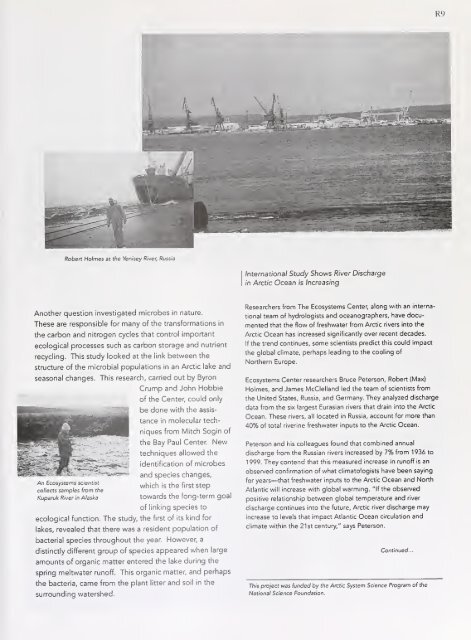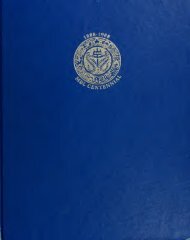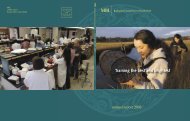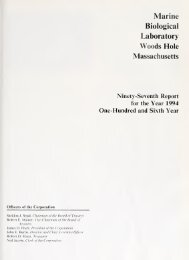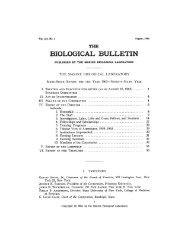View/Open - HPS Repository - Arizona State University
View/Open - HPS Repository - Arizona State University
View/Open - HPS Repository - Arizona State University
Create successful ePaper yourself
Turn your PDF publications into a flip-book with our unique Google optimized e-Paper software.
.<br />
R9<br />
Robert Holmes at the Yem'sey River, Russia<br />
International Study Shows River Discharge<br />
in Arctic Ocean is Increasing<br />
Another question investigated microbes in nature.<br />
These are responsible for many of the transformations in<br />
the carbon and nitrogen cycles that control important<br />
ecological processes such as carbon storage and nutrient<br />
recycling. This study looked at the link between the<br />
structure of the microbial populations<br />
in an Arctic lake and<br />
seasonal changes.<br />
An Ecosystems scientist<br />
Researchers<br />
collects samples from the<br />
Kuparuk River in Alaska<br />
This research, carried out by Byron<br />
Crump and John Hobbie<br />
of the Center, could only<br />
be done with the assistance<br />
in molecular techniques<br />
from Mitch Sogin of<br />
the Bay Paul Center. New<br />
techniques allowed the<br />
identification of microbes<br />
and species changes,<br />
which is the first step<br />
towards the long-term goal<br />
of linking species to<br />
ecological function. The study, the first of its kind for<br />
lakes, revealed that there was a resident population of<br />
bacterial species throughout the year.<br />
However, a<br />
distinctly different group of species appeared when large<br />
amounts of organic matter entered the lake during the<br />
spring meltwater runoff. This organic matter, and perhaps<br />
the bacteria, came from the plant<br />
litter and soil in the<br />
surrounding watershed.<br />
from The Ecosystems Center, along with an international<br />
team of hydrologists and oceanographers, have documented<br />
that the flow of freshwater from Arctic rivers into the<br />
Arctic Ocean has increased significantly over recent decades.<br />
If the trend continues, some scientists predict this could impact<br />
the global climate, perhaps leading to the cooling of<br />
Northern Europe.<br />
Ecosystems Center researchers Bruce Peterson, Robert (Max)<br />
Holmes, and James McClelland led the team of scientists from<br />
the United <strong>State</strong>s, Russia, and Germany. They analy2ed discharge<br />
data from the six largest Eurasian rivers that drain into the Arctic<br />
Ocean. These rivers, all located in Russia, account for more than<br />
40% of total riverine freshwater inputs to the Arctic Ocean.<br />
Peterson and his colleagues found that combined annual<br />
discharge from the Russian rivers increased by 7% from 1936 to<br />
1999. They contend that this measured increase in runoff is an<br />
observed confirmation of what climatologists have been saying<br />
for years that freshwater inputs to the Arctic Ocean and North<br />
Atlantic will increase with global warming.<br />
"If the observed<br />
positive relationship between global temperature and river<br />
discharge continues into the future, Arctic river discharge may<br />
increase to levels that impact Atlantic Ocean circulation and<br />
climate within the 21st century," says Peterson.<br />
Continued. .<br />
This project was funded by the Arctic System Science Program of the<br />
National Science Foundation.


